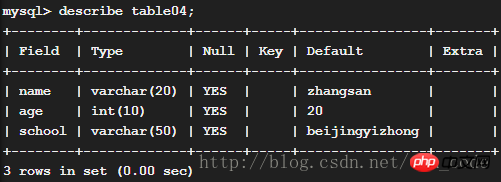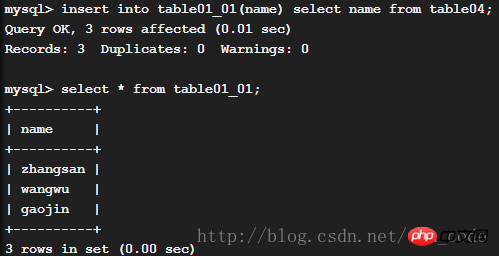A brief discussion on MySQL drifting (6)
Review the previous MySQL drifting story (1):
Add data:
Here we want to talk about, what should we do if we add multiple pieces of data?
Grammar: insert into table name values(…,…,…)
Case: insert into table04 values('wangwu',19,'beijing'),('gaojin',31,'nanjing');
Among them, values are written to correspond to the fields when the table was created. They must be assigned once in the order when the table was created. If you forget the order of the fields when the table was created at this time, it does not matter. Use:
Syntax: describe The table name
can help us check the order when creating the table. 
can give the column to be assigned a value, and then list the values. This is useful for those who wish to create records where only a few columns need to be initially set:
(1)insert test04(name) values('Jack');
(2)insert test01_01(name) values('Jack'),('baidu');
(3)insert test01_01 set name='Tencent';
//Using (3) this form of insert statement cannot insert multiple rows
insert…into…select.. statement:
Before we introduced that we can use the select statement to create a table, now we use the insert…into…select statement to provide us with convenience:
Use the insert into... select statement to meet the following conditions:
1: The query cannot contain an order by clause
2: The destination table of the insert statement cannot appear in the from clause of the select query part, because this is ANSI SQL prohibits selecting from the table you are inserting into. The problem is that select will likely find records that were previously inserted during the same run. When using sub-select clauses, the situation can be easily confused
Syntax example:
1)insert into table01_01 select * from table01_01;//Equivalent to copy, the table structure is completely consistent
2)insert into table01_01(name) select name from table04;//When copying – just take a certain value and add it
Review the previous MySQL drifting story (1):
Add data:
Here we want to talk about, what should we do if we add multiple pieces of data?
Grammar: insert into table name values(…,…,…)
Case: insert into table04 values('wangwu',19,'beijing'),('gaojin',31,'nanjing');
Among them, values are written to correspond to the fields when the table was created. They must be assigned once in the order when the table was created. If you forget the order of the fields when the table was created at this time, it does not matter. Use:
Syntax: describe The table name
can help us check the order when creating the table. 
can give the column to be assigned a value, and then list the values. This is useful for those who wish to create records where only a few columns need to be initially set:
(1)insert test04(name) values('Jack');
(2)insert test01_01(name) values('Jack'),('baidu');
(3)insert test01_01 set name='Tencent';
//Using (3) this form of insert statement cannot insert multiple rows
insert…into…select.. statement:
Before we introduced that we can use the select statement to create a table, now we use the insert…into…select statement to provide us with convenience:
Use the insert into... select statement to meet the following conditions:
1: The query cannot contain an order by clause
2: The destination table of the insert statement cannot appear in the from clause of the select query part, because this is ANSI SQL prohibits selecting from the table you are inserting into. The problem is that select will likely find records that were previously inserted during the same run. When using sub-select clauses, the situation can be easily confused
Syntax example:
1)insert into table01_01 select * from table01_01;//Equivalent to copy, the table structure is completely consistent
2)insert into table01_01(name) select name from table04;//When copying – only take a certain value and add 
The above is the detailed content of A brief discussion on MySQL drifting (6). For more information, please follow other related articles on the PHP Chinese website!

Hot AI Tools

Undresser.AI Undress
AI-powered app for creating realistic nude photos

AI Clothes Remover
Online AI tool for removing clothes from photos.

Undress AI Tool
Undress images for free

Clothoff.io
AI clothes remover

AI Hentai Generator
Generate AI Hentai for free.

Hot Article

Hot Tools

Notepad++7.3.1
Easy-to-use and free code editor

SublimeText3 Chinese version
Chinese version, very easy to use

Zend Studio 13.0.1
Powerful PHP integrated development environment

Dreamweaver CS6
Visual web development tools

SublimeText3 Mac version
God-level code editing software (SublimeText3)

Hot Topics
 PHP's big data structure processing skills
May 08, 2024 am 10:24 AM
PHP's big data structure processing skills
May 08, 2024 am 10:24 AM
Big data structure processing skills: Chunking: Break down the data set and process it in chunks to reduce memory consumption. Generator: Generate data items one by one without loading the entire data set, suitable for unlimited data sets. Streaming: Read files or query results line by line, suitable for large files or remote data. External storage: For very large data sets, store the data in a database or NoSQL.
 How to optimize MySQL query performance in PHP?
Jun 03, 2024 pm 08:11 PM
How to optimize MySQL query performance in PHP?
Jun 03, 2024 pm 08:11 PM
MySQL query performance can be optimized by building indexes that reduce lookup time from linear complexity to logarithmic complexity. Use PreparedStatements to prevent SQL injection and improve query performance. Limit query results and reduce the amount of data processed by the server. Optimize join queries, including using appropriate join types, creating indexes, and considering using subqueries. Analyze queries to identify bottlenecks; use caching to reduce database load; optimize PHP code to minimize overhead.
 How to use MySQL backup and restore in PHP?
Jun 03, 2024 pm 12:19 PM
How to use MySQL backup and restore in PHP?
Jun 03, 2024 pm 12:19 PM
Backing up and restoring a MySQL database in PHP can be achieved by following these steps: Back up the database: Use the mysqldump command to dump the database into a SQL file. Restore database: Use the mysql command to restore the database from SQL files.
 How to insert data into a MySQL table using PHP?
Jun 02, 2024 pm 02:26 PM
How to insert data into a MySQL table using PHP?
Jun 02, 2024 pm 02:26 PM
How to insert data into MySQL table? Connect to the database: Use mysqli to establish a connection to the database. Prepare the SQL query: Write an INSERT statement to specify the columns and values to be inserted. Execute query: Use the query() method to execute the insertion query. If successful, a confirmation message will be output.
 How to fix mysql_native_password not loaded errors on MySQL 8.4
Dec 09, 2024 am 11:42 AM
How to fix mysql_native_password not loaded errors on MySQL 8.4
Dec 09, 2024 am 11:42 AM
One of the major changes introduced in MySQL 8.4 (the latest LTS release as of 2024) is that the "MySQL Native Password" plugin is no longer enabled by default. Further, MySQL 9.0 removes this plugin completely. This change affects PHP and other app
 How to use MySQL stored procedures in PHP?
Jun 02, 2024 pm 02:13 PM
How to use MySQL stored procedures in PHP?
Jun 02, 2024 pm 02:13 PM
To use MySQL stored procedures in PHP: Use PDO or the MySQLi extension to connect to a MySQL database. Prepare the statement to call the stored procedure. Execute the stored procedure. Process the result set (if the stored procedure returns results). Close the database connection.
 How to create a MySQL table using PHP?
Jun 04, 2024 pm 01:57 PM
How to create a MySQL table using PHP?
Jun 04, 2024 pm 01:57 PM
Creating a MySQL table using PHP requires the following steps: Connect to the database. Create the database if it does not exist. Select a database. Create table. Execute the query. Close the connection.
 The difference between oracle database and mysql
May 10, 2024 am 01:54 AM
The difference between oracle database and mysql
May 10, 2024 am 01:54 AM
Oracle database and MySQL are both databases based on the relational model, but Oracle is superior in terms of compatibility, scalability, data types and security; while MySQL focuses on speed and flexibility and is more suitable for small to medium-sized data sets. . ① Oracle provides a wide range of data types, ② provides advanced security features, ③ is suitable for enterprise-level applications; ① MySQL supports NoSQL data types, ② has fewer security measures, and ③ is suitable for small to medium-sized applications.






